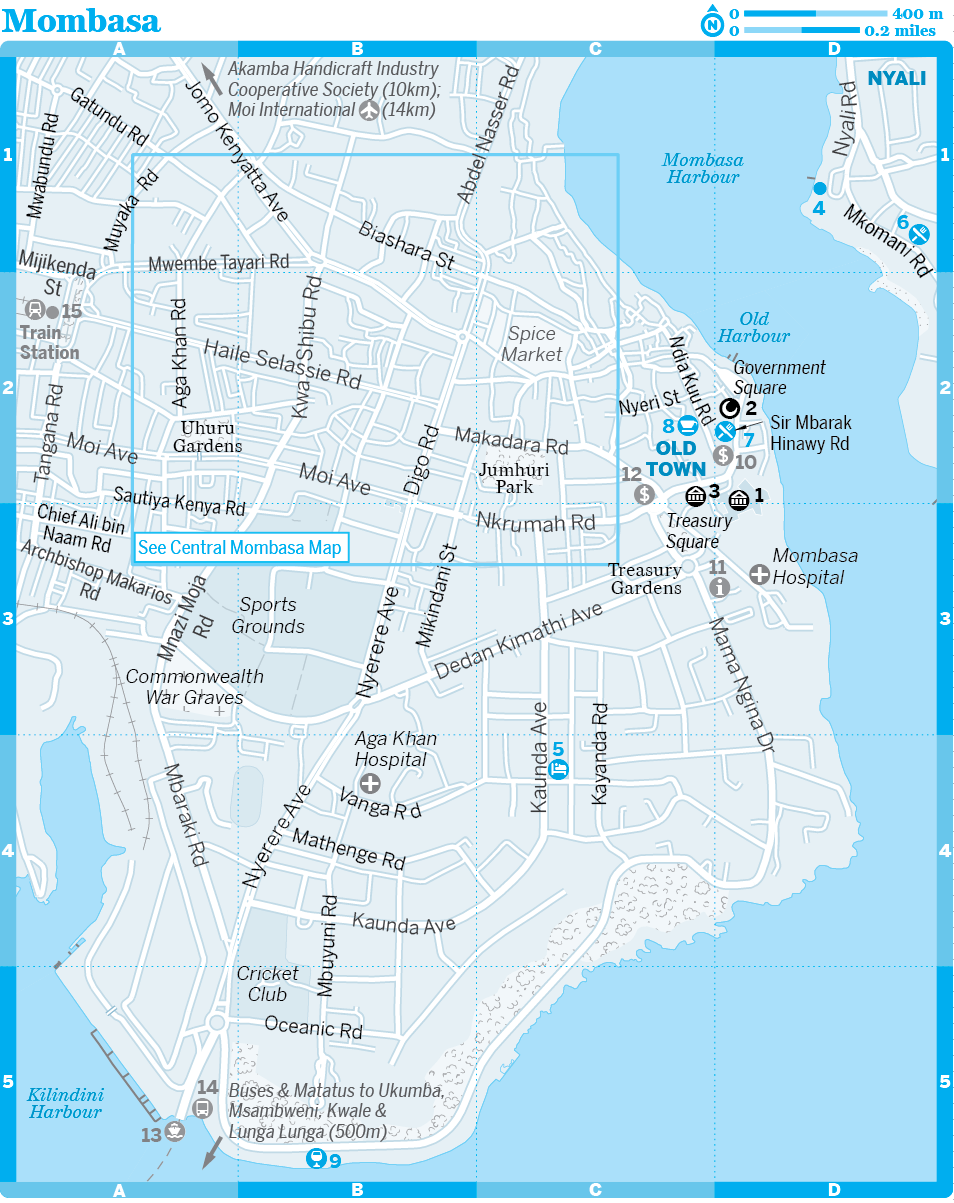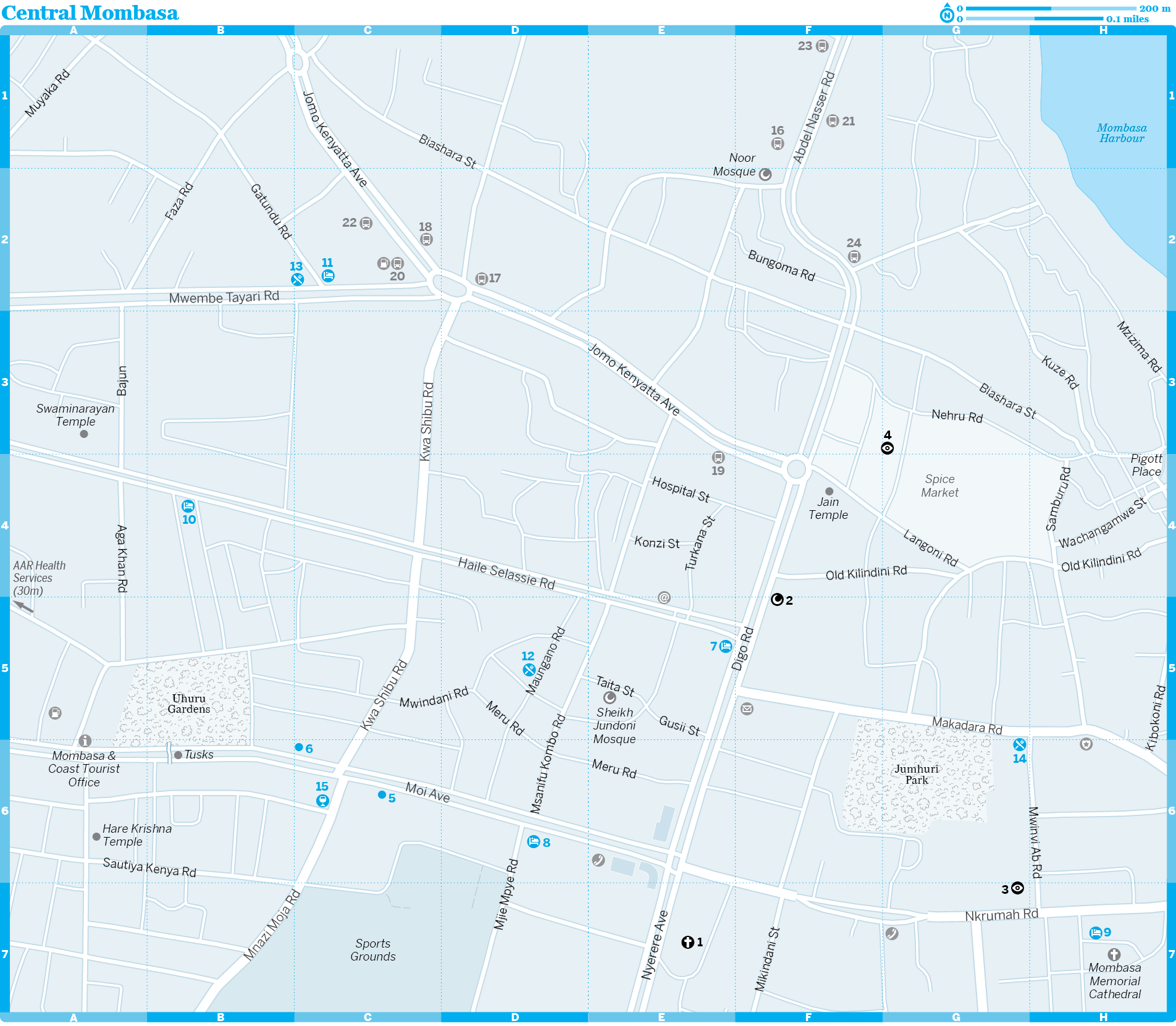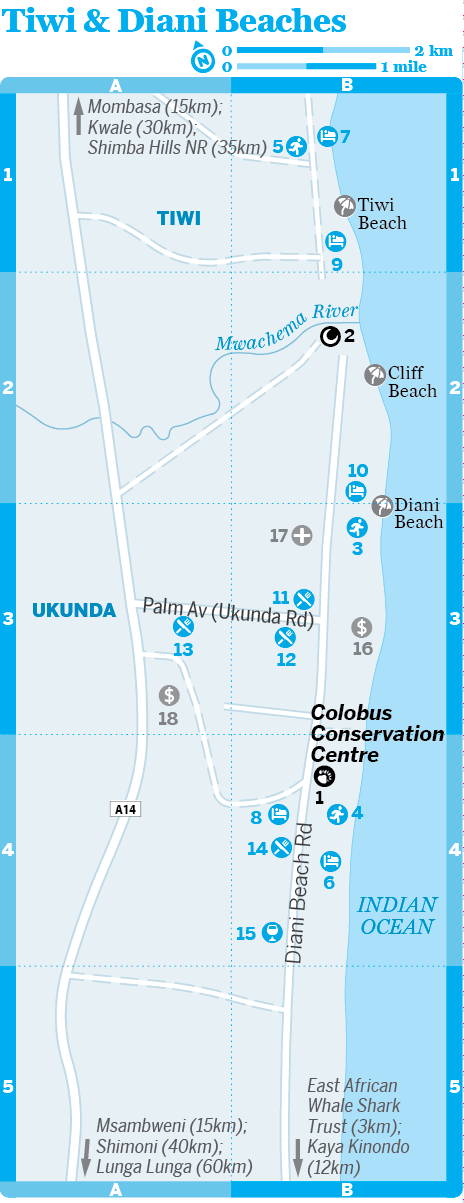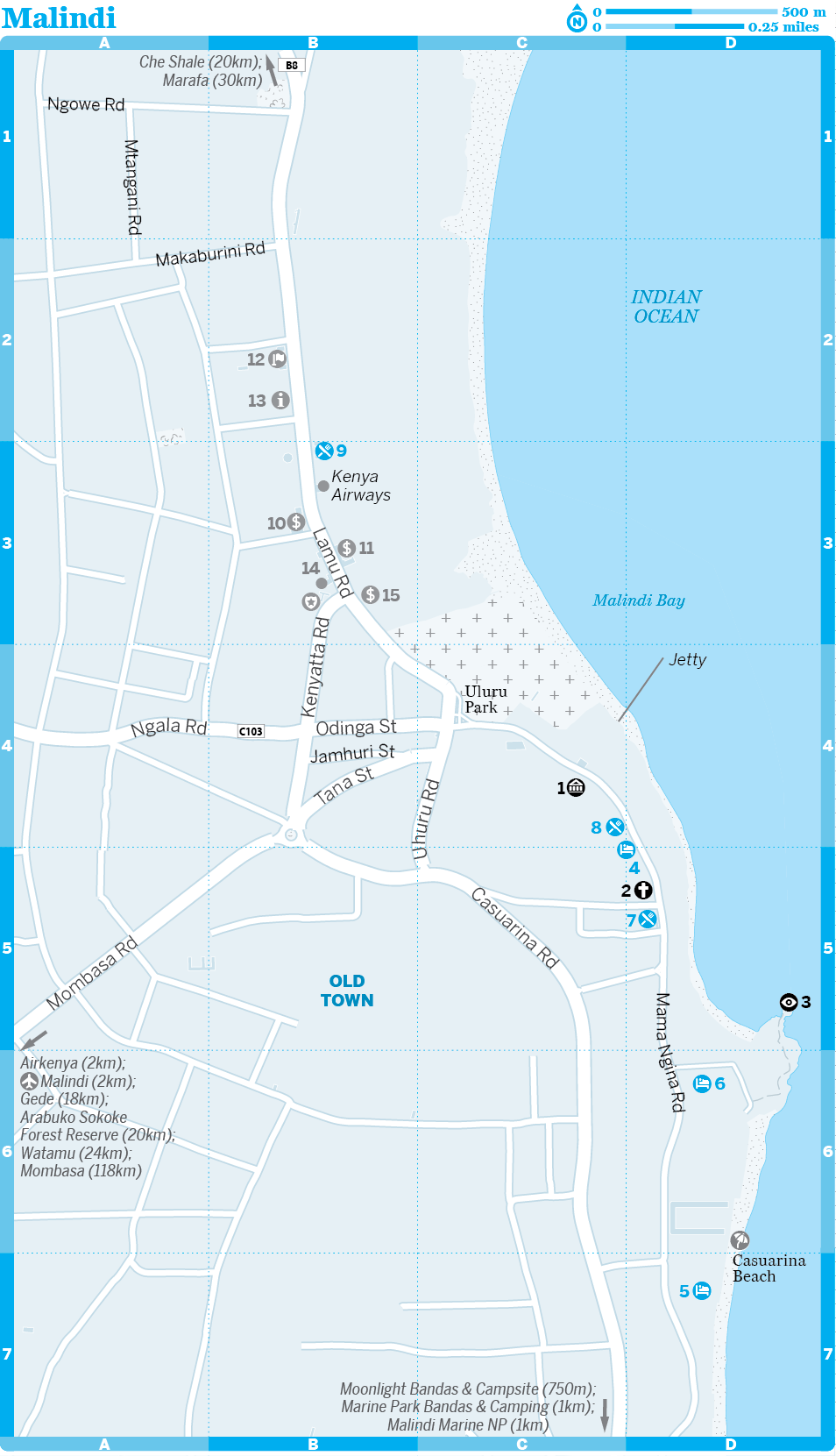Tsavo West National Park
Welcome to the wilderness. Tsavo West (
MAP
GOOGLE MAP
; ![]() %043-30049, 0724954745, Nairobi 020-600800; www.kws.org/parks/parks_reserves/TWNP; adult/child per day US$75/40;
%043-30049, 0724954745, Nairobi 020-600800; www.kws.org/parks/parks_reserves/TWNP; adult/child per day US$75/40; ![]() h6am-6pm) is one of Kenya’s larger national parks (9065 sq km), covering a huge variety of landscapes, from swamps, natural springs and rocky peaks to extinct volcanic cones, rolling plains and sharp outcrops dusted with greenery.
h6am-6pm) is one of Kenya’s larger national parks (9065 sq km), covering a huge variety of landscapes, from swamps, natural springs and rocky peaks to extinct volcanic cones, rolling plains and sharp outcrops dusted with greenery.
This is a park with a whiff of legend about it, first for its famous man-eating lions in the late 19th century and then for its devastating levels of poaching in the 1980s. Despite the latter, there’s still plenty of wildlife here, although you’ll have to work harder and be much more patient than in Amboseli or the Masai Mara to see them all. If possible, come here with some time to spare to make the most of it.

Tsavo East & West National Parks
1Top Sights
1Sights
4Sleeping
1Sights & Activities
Ngulia Rhino SanctuaryWILDLIFE RESERVE
(
MAP
GOOGLE MAP
; ![]() h4-6pm)
h4-6pm)
At the base of Ngulia Hills, this 90-sq-km area is surrounded by a 1m-high electric fence, and provides a measure of security for, at last count, 78 of the park's highly endangered black rhinos. There are driving tracks and waterholes within the enclosed area, but the rhinos are mainly nocturnal and the chances of seeing one are slim – black rhinos, apart from being understandably shy and more active at night, are browsers, not grazers and prefer to pass their time in thick undergrowth.
Rhino ValleyPARK
( MAP GOOGLE MAP )
This is one of our favourite areas for wildlife watching, with plenty of antelope species keeping a careful eye out for the resident lions, leopards and cheetahs. You’ll also see elephants, giraffes and, if you’re lucky, black rhinos. Birdlife is also particularly diverse here. The signposted ‘Rhino Valley Circuit’ is a good place to start, while anywhere along the Mukui River’s ponds and puddles is a place to watch and wait.
Ngulia HillsMOUNTAIN
Rising more than 600m above the valley floor and to a height over 1800m above sea level, this jagged ridgeline ranks among the prettiest of all Tsavo landforms, providing a backdrop to Rhino Valley. The hills can be climbed with permission from the warden, while the peaks are also a recognised flyway for migrating birds heading south from late September through to November.
Mzima SpringsSPRING
( MAP GOOGLE MAP )
Mzima Springs is an oasis of green in the west of the park and produces an incredible 250 million litres of fresh water a day. The springs, whose source rises in the Chyulu Hills, provides the bulk of Mombasa’s fresh water. A walking trail leads along the shoreline. The drought in 2009 took a heavy toll on the springs’ hippo population; the population is stable at around 20 individuals. There are also crocodiles and a wide variety of birdlife.
Chyulu Gate & the WestPARK
The plains, rocky outcrops and light woodland between Kilaguni Serena Lodge and the Chyulu gate are good for zebras and other herbivores, and sustains a healthy population of lions, leopards and spotted hyenas – the epic battle between rival hyena clans that we witnessed here on our last visit remains one of our favourite Tsavo memories. A leopard was also commonly seen early morning along the road close to the airstrip.
Chaimu Crater & Roaring RocksLOOKOUT
( MAP GOOGLE MAP )
Just southeast of Kilaguni Serena Lodge, these two natural features offer stunning views of the Chyulu Hills and birds of prey circling high above the plains. The Roaring Rocks can be climbed in about 15 minutes; the name comes from the wind whistling up the escarpment and the persistent drone of cicadas. While there’s little danger when walking these trails, the KWS warns in its guidebook to the park that in Chaimu Crater ‘be wary when exploring since the crater and lava may shelter snakes and large sleeping mammals’.
![]() oShetani Lava FlowsLOOKOUT, VOLCANO
oShetani Lava FlowsLOOKOUT, VOLCANO
( MAP GOOGLE MAP )
About 4km west of the Chyulu gate of Tsavo West National Park, on the road to Amboseli, are the spectacular Shetani lava flows. ‘Shetani’ means ‘devil’ in Kiswahili: the flows were formed only a few hundred years ago and local peoples believed that it was the devil himself emerging from the earth. This vast expanse of folded black lava spreads for 50 sq km across the savannah at the foot of the Chyulu Hills, looking strangely as if Vesuvius dropped its comfort blanket here.
Tsavo River & the SouthRIVER
Running west–east through the park, this lovely year-round river is green-shaded and surrounded for much of its path by doum palms. Along with Mzima Springs, the river provides aesthetic relief from the vast semi-arid habitats that dominate the park. The trees all along the river are known to shelter leopards.
TSAVO WEST NATIONAL PARK
Why Go
For the dramatic scenery, wilderness and good mix of predators (lion, leopard, cheetah and hyena), prey (lesser kudu, gazelle, impala) and other herbivores (elephant, rhino, zebra, oryx and giraffe).
When to Go
Year-round. The dry season (May to October and January to March) is best for spotting wildlife. November to March is the best time to see migratory birds.
Practicalities
Drive in from Mtito Andei or Tsavo Gate along the Nairobi–Mombasa Rd. There is a campsite close to the park entrance and lodges throughout the park.
Budget Tips
Rent a matatu with other travellers in Mtito Andei; if staying in a lodge, June is much cheaper than July.
4Sleeping & Eating
KWS CampsiteCAMPGROUND
( GOOGLE MAP ; camping US$20)
This public campsite is at Komboyo, near the Mtito Andei gate. Facilities are basic, so be prepared to be self-sufficient.
Kitani BandasBANDAS
(
MAP
GOOGLE MAP
; ![]() %041-211000, Nairobi 020-2684247; www.severinsafaricamp.com; bandas s/d US$81/124;
%041-211000, Nairobi 020-2684247; www.severinsafaricamp.com; bandas s/d US$81/124; ![]() p
p![]() W
W![]() s)
s)
Run by the same people as Severin Safari Camp, Kitani is located next to a waterhole, about 2km past its sister site, and offers the cheapest Kili views in the park. These bandas (which have their own simple kitchens), have far more style than your average budget camp and you can use Severin’s facilities (including the pool and free wi-fi). Great value.
![]() oRhino Valley LodgeBANDAS
oRhino Valley LodgeBANDAS
(Ngulia Bandas;
MAP
GOOGLE MAP
; ![]() %0721328567; www.tsavolodgesand camps.com; bandas s/d US$150/200;
%0721328567; www.tsavolodgesand camps.com; bandas s/d US$150/200; ![]() p)
p)
This hillside camp is one of Tsavo’s best bargains and one of the most reasonably priced choices in the parks of southern Kenya. The thatched stone cottages and tents perch on the lower slopes of the Ngulia Hills with sweeping views of Rhino Valley, overlooking a stream where leopards are known to hide out. The decor is designer rustic with plenty of space and private terraces.
![]() oKilaguni Serena LodgeLODGE
oKilaguni Serena LodgeLODGE
(
MAP
GOOGLE MAP
; ![]() %045-622376; www.serenahotels.com; s/d US$240/320;
%045-622376; www.serenahotels.com; s/d US$240/320; ![]() i
i![]() s)
s)
As you’d expect from the upmarket Serena chain, this lodge is extremely comfortable with semi-luxurious rooms, many of which have been recently renovated. The centrepiece here is a splendid bar and restaurant overlooking a busy illuminated waterhole – the vista stretches all the way from Mt Kilimanjaro to the Chyulu Hills.
Severin Safari CampTENTED CAMP
(
MAP
GOOGLE MAP
; ![]() %Nairobi 020-2684247; www.severinsafaricamp.com; s/d full board from US$240/370;
%Nairobi 020-2684247; www.severinsafaricamp.com; s/d full board from US$240/370; ![]() p
p![]() W
W![]() s)
s)![]() S
S
This fantastic complex of thatched luxury tents just keeps getting better. They’ve recently overhauled the tents, added a luxury swimming pool and spa, and even a tented gym. The staff offers a personal touch, the food is outstanding and the tents are large and luxurious despite costing considerably less than others elsewhere in the park. Hippo and lion visits are fairly frequent and there are Kilimanjaro views from some points on the property.
Finch Hatton’s Safari CampTENTED CAMP
(
MAP
GOOGLE MAP
; ![]() %0716021818, Nairobi 020-8030936; www.finchhattons.com; s/d US$1000/1580, luxury family tent US$3360, presidential ste US$3750;
%0716021818, Nairobi 020-8030936; www.finchhattons.com; s/d US$1000/1580, luxury family tent US$3360, presidential ste US$3750; ![]() p
p![]() W
W![]() s)
s)![]() S
S
This upmarket tented camp, which is distinguished by its signature bone china and gold shower taps (guests are requested to dress for dinner), was named after Denys Finch Hatton, the playboy hunter and lover of Karen Blixen. He died at Tsavo, despite his obsession with maintaining civility in the middle of the bush.
POACHING IN TSAVO
As poaching reached epidemic proportions in Kenya in the 1980s, Tsavo was very much on the frontline – not surprising given the park’s size and terrain. In a few short years, the elephant population dropped from 45,000 to just 5000, and rhinos were almost wiped out entirely; at the height of the crisis, an estimated 5000 elephants were being killed every year. Populations are slowly recovering, and, as of early 2011, there are close to 12,500 elephants in the two parks, but less than 100 rhinos, down from about 9000 in 1969.
Sadly, there has been a recent upsurge in poaching once again, with the northern half of Tsavo East (off-limits to travellers) of particular concern, as well as many areas bordering the two Tsavo parks; the area around Maktau Gate at the southern edge of Tsavo West has been particularly hard hit.
8Information
Fuel is generally available at Kilaguni Serena Lodge and Severin Safari Camp; fill up before entering park.
The Tsavo West National Park map and guidebook is available from Mtito Andei Gate.
8Getting There & Away
There are six gates into Tsavo West, but the main access is off the Nairobi-Mombasa Highway at Mtito Andei and Tsavo Gates.
Tsavo East National Park
Kenya’s largest national park, Tsavo East National Park (
MAP
GOOGLE MAP
; ![]() %0775563672, 0722290009, Nairobi 020-6000800; www.kws.org/parks/parks_reserves/TENP; adult/child per day US$75/40;
%0775563672, 0722290009, Nairobi 020-6000800; www.kws.org/parks/parks_reserves/TENP; adult/child per day US$75/40; ![]() h6am-6pm) has an undeniable wild and primordial charm and is a terrific wildlife-watching destination. Although one of Kenya’s largest rivers flows through the middle of the park and the contrast between the permanent greenery of the river and the endless grasses and thorn trees that characterise much of the park is visually arresting, the landscape here lacks the drama of Tsavo West. Tsavo East is markedly flatter and drier than its sister park. The flipside is that spotting wildlife is generally easier thanks to the thinly spread foliage.
h6am-6pm) has an undeniable wild and primordial charm and is a terrific wildlife-watching destination. Although one of Kenya’s largest rivers flows through the middle of the park and the contrast between the permanent greenery of the river and the endless grasses and thorn trees that characterise much of the park is visually arresting, the landscape here lacks the drama of Tsavo West. Tsavo East is markedly flatter and drier than its sister park. The flipside is that spotting wildlife is generally easier thanks to the thinly spread foliage.
TSAVO EAST NATIONAL PARK
Why Go
Wilderness, red elephants and leopards, lions and cheetahs. The park also has close to 500 bird species.
When to Go
June to February. Wildlife concentrations are highest in the dry season (September to October and January to early March).
Practicalities
Drive in from Voi, Mandanyi or Tsavo gates along the Nairobi–Mombasa Rd. The Sala and Buchuma gates are good for Mombasa. There are a small number of lodges and camps throughout the park or close to Voi Gate.
Budget Tips
Rent a matatu or organise a budget safari with other travellers in Voi or the coast; use public campsites.
1Sights & Activities
Kanderi SwampRIVER
Around 10km from Voi Gate, the lovely area of green known as Kanderi Swamp is home to a resident pride of lions, and elephants also congregate near here; this is one of only two water sources in the park during the dry season. The landscape here has a lovely backdrop of distant hills. A number of vehicle tracks also follow the contours of the Voi River; keep an eye on the overhanging branches for leopards.
Aruba DamLAKE
( MAP GOOGLE MAP )
Some 30km east of Voi Gate is the Aruba Dam, which spans the Voi River. It also attracts heavy concentrations of diverse wildlife; one the park’s regularly spotted lion prides ranges around here. Away to the east and southeast, all the way down to the Buchuma Gate, the open grasslands provide the perfect habitat for cheetahs and sightings are more common here than anywhere else in southeastern Kenya.
Galana RiverRIVER
Running through the heart of the park and marking the northernmost point in the park that most visitors are allowed to visit, the Galana River, which combines the waters of the Tsavo and Athi Rivers, cuts a green gash across the dusty plains. Surprisingly few visitors make it even this far and sightings of crocs, hippos, lesser kudus, waterbucks, dikdiks and, to a lesser extent, lions and leopards are relatively common.
Mudanda RockMOUNTAIN
( MAP GOOGLE MAP )
Towering over a natural dam near the Manyani gate, this natural formation runs for over 1.5km. It attracts elephants in the dry season and is reminiscent of Australia’s Uluru (Ayers Rock), albeit on a smaller scale. Leopards and elephants are among the wildlife to watch out for here.
4Sleeping & Eating
Inside the Park
KWS CampsiteCAMPGROUND
( MAP GOOGLE MAP ; camping US$20)
Decent site with toilets, showers and a communal kitchen.
Voi Safari LodgeLODGE
(
MAP
GOOGLE MAP
; ![]() %Mombasa 041-4718610; www.safari-hotels.com; s/d US$190/290;
%Mombasa 041-4718610; www.safari-hotels.com; s/d US$190/290; ![]() W
W![]() s)
s)
Just 4km from Voi Gate, this is a long, low complex perched on the edge of an escarpment overlooking an incredible sweep of savannah. There’s an attractive rock-cut swimming pool, as well as a natural waterhole that draws elephants, buffaloes and the occasional predator; a photographers’ hide sits at the level of the waterhole. Rooms are attractive and many have superlative views.
Ashnil Aruba LodgeLODGE
(
MAP
GOOGLE MAP
; ![]() %Nairobi 020-4971008; www.ashnilhotels.com; s/d full board US$262/350;
%Nairobi 020-4971008; www.ashnilhotels.com; s/d full board US$262/350; ![]() p
p![]() i
i![]() s)
s)
A stone’s throw from the wildlife-rich Aruba Dam, this lodge has attractively decorated rooms decked out in safari prints. In the heart of the park, it’s an ideal starting point for most Tsavo East safaris. Wildlife wanders around the property’s perimeter at regular intervals.
Satao CampTENTED CAMP
(
MAP
GOOGLE MAP
; ![]() %Mombasa 041-475074, Nairobi 020-2434600; www.sataocamp.com; s/d US$337/436;
%Mombasa 041-475074, Nairobi 020-2434600; www.sataocamp.com; s/d US$337/436; ![]() p)
p)
Located on the banks of the Voi River, this luxury camp is run by the experienced safari operator Southern Cross Safaris. There are 20 canopied tents, all of which are perfectly spaced within sight of a waterhole that’s known to draw lions, cheetahs and elephants on occasion.
Outside the Park
![]() oTsavo Mashariki CampTENTED CAMP
oTsavo Mashariki CampTENTED CAMP
(
MAP
GOOGLE MAP
; ![]() %0729179443; www.masharikicamp.com; s/d from US$131/185)
%0729179443; www.masharikicamp.com; s/d from US$131/185)
The closest camp to Voi Gate just outside the park, this charming little Italian-run place has some fine tents made out of all-natural local materials; the family tent is brilliant and there are also two stone-built cottages. Best of all, the prices here put many other tented camps to shame. Highly recommended.
8Information
Fuel is available in Voi; fill up before entering park.
The Tsavo East National Park map and guidebook is available from Voi Gate.
8Getting There & Away
A track through the park follows the Galana River from the Tsavo gate to the Sala gate; others fan out from Voi gate.
If travelling to/from Nairobi or Tsavo West, use the Voi, Tsavo and Manyani gates, to/from Mombasa use the Sala or Buchuma gates.
Voi
pop pop 17,152
Voi is a key service town at the intersection of the Nairobi–Mombasa road, the road to Moshi in Tanzania and the access road to the main Voi gate of Tsavo East National Park. While there is little reason to spend any more time here than is needed to get directions, fill up on petrol, change money and buy some snacks for the road, you’ll inevitably pass through here at some point.
Frequent buses and matatus run to/from Mombasa (KSh200 to KSh500, three hours), and buses to Nairobi (KSh500 to KSh1200, six hours). There are at least daily matatus to Taveta (KSh450, two hours), on the Tanzanian border.




